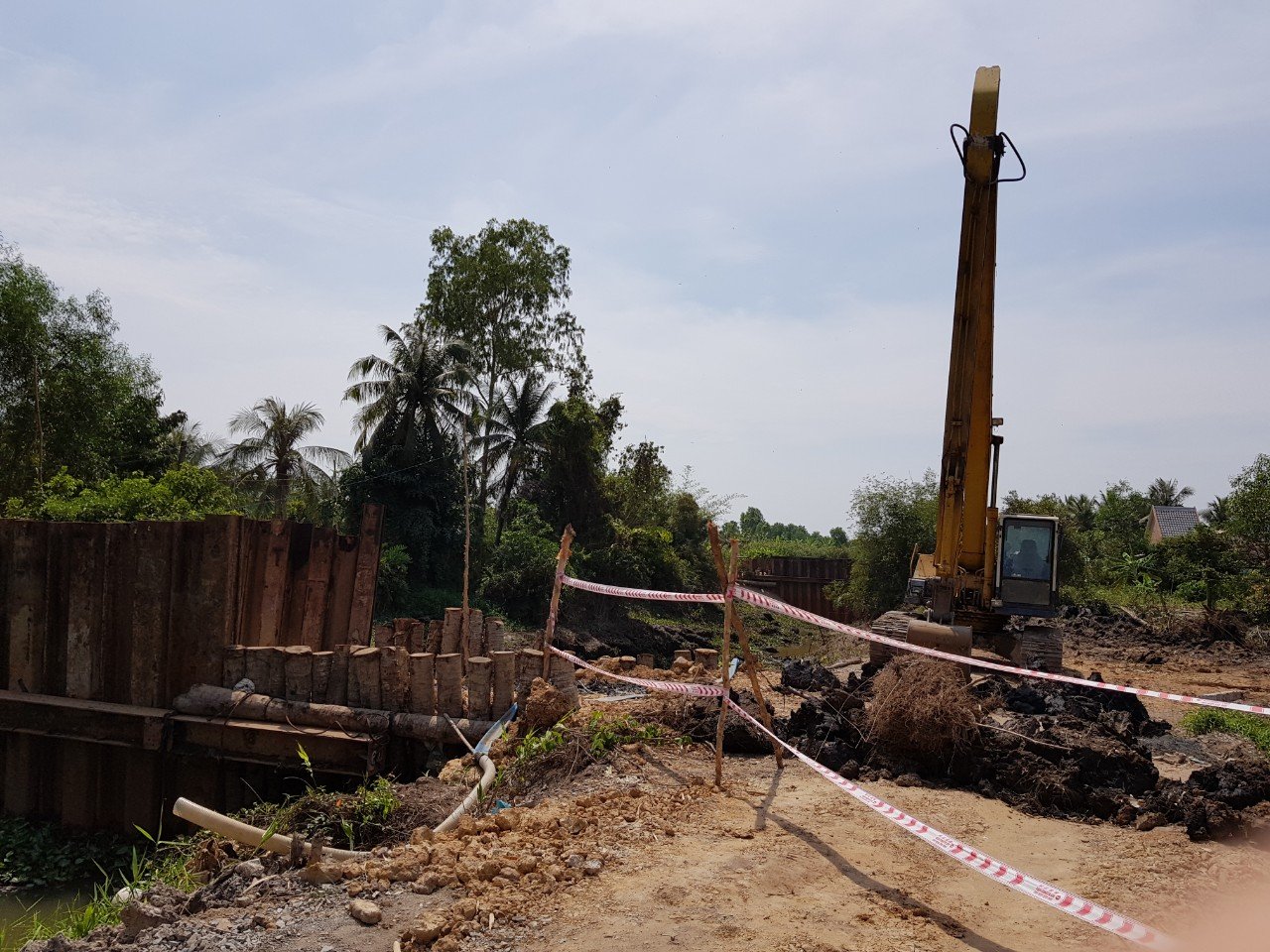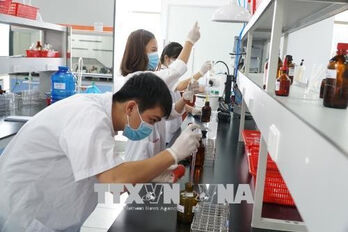Drought and salinity in the year 2020-2021 are still complicated and unpredictable
In the dry season 2019-2020, Long An province and other provinces in the Mekong River Delta (MRD) faced the largest drought and saline intrusion in history with a severe, complicated and unpredictable level. Although the People's Committee of the province, the Agriculture sector and localities early commented on the situation and proactively in the prevention, combat, response to the drought, water shortage, saline intrusion, damage in agriculture production is still unavoidable.
According to statistics, due to the impact of drought and salinity in the dry season 2019-2020, the province had about 860 hectares of rice were totally lost, 1,900 hectares were reduced yield from 30-70 percent, along with many areas of lemon cultivation in the districts of Thu Thua, Tan Tru and Tan An city were damaged by alum, salinity and heat shock. It was estimated that total cost of damage caused by drought and salinity in the province in 2019-2020 was 55 billion VND, a deep decrease compared with the damage caused by drought, salinity in the history of 2015-2016 is 194 billion VND.
.jpg)
The Provincial People's Committee requests the Rach Chanh Sluice Management Board to coordinate in operating the work to ensure fresh water sources for Long An and Tien Giang provinces
Information from the General Department of Meteorology and Hydrology, Ministry of Agriculture and Rural Development (MARD), the total amount of flow in the dry season 2020-2021 from the upper Mekong River to the MRD is a shortage of 20- 35 percent compared to the average of many years, water shortages and saline intrusion are likely to occur early and severe in the dry season 2020-2021. According to the Southern Institute of Water Resources Science, the flow of the dry season 2020-2021 from the upper Mekong River to the MRD is likely to belong to the extremely low hydrological year, so saline intrusion in the dry season in the MRD belongs to the group of five serious issues such as early come, deeply penetrate on a large scale, last, cause a great impact on people’s production and daily life.
Director of Sub-department of Rural Development and Irrigation - Vo Kim Thuan said: “Currently, the drought and saline intrusion is about to enter the period of peak impact at the end of February, salinity 4.0 gram per liter. It is possible to penetrate deeply into the main stream, estuaries of the Mekong River 48-70 kilometers and from 75-90 kilometers on the Vam Co river. It is forecasted that the effects of strong winds can cause sudden salinity increase in the estuaries of the Mekong River, directly affecting the intake and storage of water for production”.
Water is actively taken, stored for production
Facing droughts and saline intrusion have taken place harshly in recent years, affecting daily life, especially the supply of productive water to the people, local voters constantly reflect to the People's Councils at all levels. Since then, the Provincial People's Council has synthesized and sent to the Provincial People's Committee to direct relevant functional departments and localities to synchronously implement solutions to ensure adequate supply of water for production and daily life for the people, not let the water shortage occur in this year's dry season.

The key sluices on National Highway (NH) 62 are constructed with sluices and dams to prevent salinity, ensuring fresh water storage for agriculture production
In Tan Tru district, one of the most affected localities in the drought and saline season in 2019-2020, the water level on in-field canals is still full, no damage due to drought and salinity has occurred. According to the Deputy Head of the Division of Agriculture and Rural Development of Tan Tru district - Do Huy Cuong, compared to previous years, this year, the district has actively taken water and stored water from the last months of 2020, the water produced will basically meet the people’s demand.
“This time last year, the rivers and canals of the district were dried up, there was no water for production, people reflected continuously, but this year, the district Agricultural sector has not yet recorded people's reflection yet. At the same time, with propaganda measures, people are also more aware of proactively sowing as recommended by the Agricultural sector. This year, the number of people growing rice in the third crop has decreased significantly, compared to the winter-spring crop of 2019-2020, the sowing area of the district decreased by about 1,200 hectares. In addition, the district has dredged and cleared the flow of 8 in-field irrigation works, the communes have dredged 22 canals to be proactive in the prevention, combat and response to drought and salinity by 2020 in the field with the total cost about 8 billion VND, invested 2 sluices for preventing salinity in Duc Tan and Nhut Ninh communes as well as upgraded the dyke along Vam Co Tay river with a length of nearly 7 kilometers, helped the district to be more active in the prevention and control of drought and salinity”- Deputy Head of Division of Agriculture and Rural Development of Tan Tru district - Do Huy Cuong said.
Similarly, in Can Giuoc district - the upstream district of saline intrusion, this year, the amount of water for production up to now is still basically meeting the needs of the people.
According to the Director of the Sub-Department of Rural Development and Irrigation - Vo Kim Thuan, facing the drought and saltwater intrusion in the province is happening directly to the system of 2 Vam Co rivers, so the system of sluices along the 2 river system has been closed to prevent salinity early. In addition, on NH 62 from Tan An city to Thanh Hoa district with a total of about 32 culverts and canals crossing, temporary sluices and dams have been installed to prevent saline intrusion. In the two years 2019 and 2020, the Irrigation Construction and Investment Management Board, the Ministry of Agriculture and Rural Development have invested and are implementing and implementing investment for the province 5 sluice gates in Ba Hai Mang canal, Ba Dinh canal, Thu Con canal and La Khoa canal with the residual capital of Xuan Hoa pumping station project for the province to be proactive in preventing salinity. Currently, the locations of Ben Ke canal, Bun Ba Cua canal, canal 1, canal 2, Cai Tom canal, the Agriculture sector have completed the construction of temporary dams to prevent saline intrusion into the interior fields from the Vam Co Tay river. At the same time, the Provincial People's Committee also sent a document to the Rach Chanh Sluice Management Board to propose coordination in the operation of the project to ensure fresh water sources for the two provinces of Long An and Tien Giang.
To proactively prevent and promptly respond to drought and saline intrusion in the dry season 2020-2021, ensure the supply of fresh water for agricultural production in the winter-spring crop 2020-2021 and people's livelihood with safety, efficiency and limitation of water shortage in the irrigation system, the Agricultural sector suggests localities to actively monitor the changes in salinity, have a reasonable plan to operate the main sluices to take advantage of enough water storage in canals and ditches when the salinity decreases; At the same time, inspect and thoroughly handle leaky sluice gates to cover and replace damaged manhole gates to avoid saline intrusion into the interior fields to ensure irrigation water for agriculture production and domestic water supply for the people.
“Over the past time, the Agricultural sector has received many opinions, recommendations and reflections from voters on the prevention and fight against drought, salinity, ensuring water service for production, we hope with many solutions to be implemented drastically in recent years, the damage caused by drought and salinity in the dry season this year will be reduced to the lowest level, ensuring maximum service of production water needs for people. However, we also hope that people will comply with the recommendations of the Agriculture sector, use water economically and efficiently, and do not sow out of schedule to avoid production risks during drought and annual season this year”- Director of Sub-Department of Rural Development and Irrigation - Vo Kim Thuan shared.
|
The shortage of water for domestic use is overcome in the dry season
At 13 o'clock, after a call from the people, the Vice Chairman of the People's Committee of Tan Phuoc Tay commune, Tan Tru district - Le Trung Hau rushed to the connection point of the water supply meter for the group of households to overcome the water supply problem for people.
“For many years, every Tet comes is the peak of the dry season, many households in the commune lack water for daily use. Tan Phuoc Tay commune is also a locality that often lacks water for daily use and is the most lacking in Tan Tru district, usually lasting for 2-3 months. This time of the previous year, our phones kept ringing to receive voters' comments on water supply issues. On the last day of February 2020, the military force had to support water supply for the people in the commune. However, this year, after being invested and installed a new water supply system, the water shortage in the dry season has basically been overcome, no longer as severe as every year ”- Mr. Le Trung Hau said.
In addition, up to the present, in the districts of Can Giuoc, Can Duoc and Tan Tru, there has not been a shortage of local water in the dry season this year./.
|
By Kien Dinh – Translated by Duc Tam
Source: https://baolongan.vn/giai-quyet-bai-toan-nuoc-sinh-hoat-nuoc-san-xuat-trong-mua-han-man-a110428.html
 Vietnam’s fertility plummets, workforce quality concerns mount: national survey
Vietnam’s fertility plummets, workforce quality concerns mount: national survey

.jpg)


